![]()
![]()
![]()
Use LEFT and RIGHT arrow keys to navigate between flashcards;
Use UP and DOWN arrow keys to flip the card;
H to show hint;
A reads text to speech;
30 Cards in this Set
- Front
- Back

Venus of Willendorf
|
25,000BCE limestone, Natural History Museum, Vienna
(represent of nature, conceptual ) Reproductive organs emphasized; huge breasts, belly, buttocks, navel Hair in clumps arranged in rows Deemphasized arms, face, legs; no feet--Venus was never meant to stand up Face may have been painted in; traces of paint of the body Fertility symbol? Small, only 4 1/2 inches long, meant to be handheld Venus is a clever name given to the object after its discovery as a way of comparing it to the ancient goddess of beauty |
|
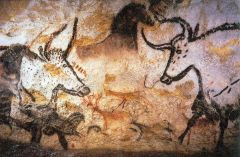
Lascaux, Hall of Bulls
|
13,500 BCE early stone age , use pigment, Dordogne.
Lascaux Caves, Dordogne, France Natural products used to make paint: charcoal, iron ore, plants 650 Paintings: most common are cows, bulls, horses, and deer Animals placed deep inside cave, some hundreds of feet from the entrance Bodies seen in profile, frontal or diagonal view of horns, eyes, and hooves; some appear pregnant Many overlapping figures Evidence still visible of scaffolding erected to get to higher areas of the caves |
|
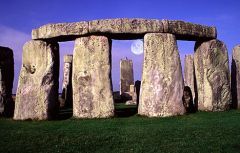
Stonehenge, Salisbury Plain
|
2000 BCE french , Dodon valley in French Wiltshire, England
Perhaps took a thousand years to build, gradually redeveloped by each succeeding generation Post-and-lintel building; lintels grooved in place by the mortise-and-tenon system of construction Large megaliths in center are over 20 feet tall and form a horseshoe surrouding a central flat zone Ring of megaliths, originally all united by lintels, surrounds central horseshoe Some stones over 50 tons Hundreds of smaller stones of unknown purpose placed around monument Some stones imported from over 200 miles away Generally thought to be oriened toward sunrise on the longest day of the year; may also predict eclipses |
|
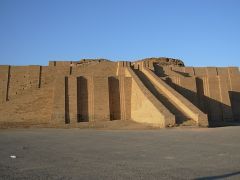
Ziggurat
|
2100 BCE, Ur, Iraq - Sumerian
Mud-brick building on a colossal scale Buttresses spaced across the surface to create a light and shadow pattern Whitewash used to disguise the mud appearance, perhaps the holes in the surface were for flags or banners to animate the facade Tapers outward so that rainwater washes off Temple on top was small, set back, and removed fro the populace Entire form resembles a mountain Four corners oriented to the compass Three large staircases lead to the upper story entrance from three different directions; guardhouse at point where the staircases meet Dedicated to the moon god Nanna |
|

palette of Narmer
|
3000 BCE old kingdom Egyptian ,register separate space ,cover 1922
-slate, Egyptian Museum, Cairo |
|
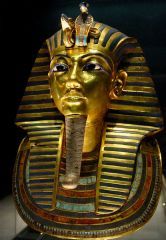
Mask of king Tut
|
1350 BCE, tapes and gold, Egyptian new kingdom
|
|
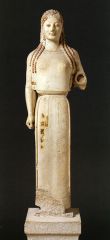
Peplos Kore
|
-Female figure, Greek art
-marble, Acropolis Museum, Athens [Archaic] (530BCE) • Broken hand used to carry offering to Athena • Hand emerges into our own space, breaks out of the mold of static Archaic statues • Tightened waist • Breasts revealed beneath drapery • So-called because she is named for the peplos garment she is wearing • Rounded naturalistic face • Much of the paint still remains, animating the face and hair |
|
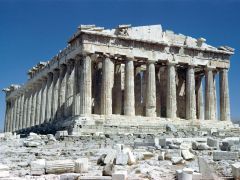
Iktinos and Kallikrates, The Parthenon, Athens
|
(447-438 BCE) Greek high classical , City of Athen
• Constructed under the leadership of Pericles after the Persian sack of Athens in 480 BCE destroyed the original Acropolis • Pericles used the extra funds in the Persian war Treasury to build the Acropolis; Greek allies were furious • Greek predilection for algebra and geometry omnipresent in the building (research equations on your own, they're lame) • Unusually light interior had two windows in the cella • Floor curves upward in the center of the façade to drain off rain water and to deflect the appearance of the sagging ends • The columns at the ends are surrounded by light, which alters their appearance, so they are made thicker in order to look the same as the other columns • Ionic elements in a Doric temple; rear room contains Ionic capitals, frieze on interior is Ionic • Interior built to house a massive statue of Athena, to whom the building was dedicated |
|
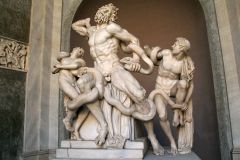
Laocoon
|
1st C. BCE emotion , realism, Greek hellenistic
|
|
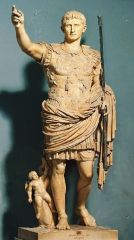
Augustus of Prima Porta
|
15 CE Romance period
Primaporta Augustus, octavian • Roman Art: Early Empire, • Typical portrait of Augustus as it shows him armed, and as a recipient of the civic crown for saving the lives of fellow citizens • Augustus’s idealized portraits were modeled on Classical Greek statues and depict him as a never-aging son of God • The cupid at Augustus’s feet alludes to his divine descent • The sculptor took a borrowing from the Greeks in that Augustus is standing in the pose of Polykleitos’s Doryphoros, but with his right arm raised to address his troops in the manner of the orator Aule Metele • Adopts a signature hair style- a fork where the hair separates and next to it, almost a pincer shape- characteristic of his image from now on • Breastplate: an event that took place in 20 BC, the Romans had lost their military insignias/standards and Augustus got them back- the historical scene is presented in a great cosmic frame- the sky above, the sky god, the sun rising and the earth down below, provinces are personified and divine figures appear- the historical event is placed in a big cosmic picture |
|

Ara Pacis
|
13 CE (Imperial period )
• Roman Art: Early Empire, • On his wife Livia’s birthday, Augustus dedicated this monument to her, which celebrated his most significant achievement, the establishment of peace • Panels depict carefully selected mythological subjects, including Aeneas who was a key element in of Augustus’s political ideology for his new Golden Age • Complex iconographic program |
|

Flavian Lady
|
90 CE (Imperial period )
Portrait of a Flavian Lady • Roman Art: Early Empire, • Purpose was to project not Republican virtues but rather idealized beauty- through contemporary fashion rather than by reference to images of Greek goddesses • Notable for its elegance and delicacy and for the virtuoso way the sculptor rendered the differing textures of hair and flesh • Her hair creates a dense mass of light and shadow set off boldly from the softly modeled and highly polished skin of the face and swanlike neck • Used the drill which played an important role |
|
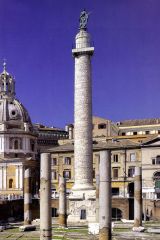
column of Trajan
|
(Imperial period )112 CE
Column of Trajan, Rome • Roman Art, The Second Century; Trajan, • The crowning achievement of the Forum • Decorated with hundreds of scenes and 2,500 individual figures carved on it • The frieze winds up the column telling the story of the Dacian wars (there were multiple) • It’s a big propaganda war memorial, and is also Trajan’s tomb • Only about ¼ of the images have anything to do with actual fighting and warfare- the others have to do with military logistics (food, clearing forests, building fortresses, etc.)- from the mundane to the spectacular • The artist took time to render each person individually • And Trajan has adopted Augustus’s look- he is clean shaven, hair is the same • Trajan became emperor through adoption- you don’t even have to be Roman anymore- the period is called “the adopted emperors” • The artist used dual perspective- we are seeing troops from the side and from above- shows they aren’t good at rendering total perspective quite yet but they want it to be aesthetically pleasing and to tell a story (and to tell the story they need all the information there) |
|
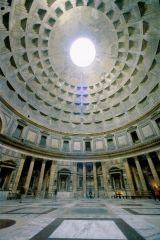
Pantheon
|
118 CE Imperial periodRoman Art, The Second Century; Hadrian,
• Octastyle temple •the exterior is the inscription- mentions Aggripo, meaning that Hadrian has rebuilt a temple and put the original dedicators name on it, much in the way that Trajan was showing the same piety to Augustus by mimicking his style • Monolithic columns- it was all cut from one piece of stone (and they’re 50 feet high)- come from a quarry down the Nile, meaning to get the granite all the way to Rome is a huge message- they didn’t break it into drums like the Greeks did- incredible logistical nightmare • The Romans loved geometry and the temple is a sphere perfectly encapsulated by the building- they admired that kind of perfection • Is thought to mimic the sky- the idea behind it is that it would represent the sky on the ceiling • Hadrian is not going for height, he is going for space- emphasizing the horizontal not the vertical • Floor: square tile, round tile, etc.- curvilinear vs. rectilinear space- the effect is dynamic, adding motion and liveliness |
|
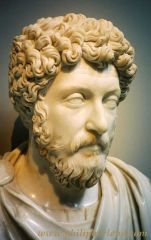
Marcus aurelius
|
(Imperial period ) 175 CE taking after Hadrian with the beard, in-sized eyes and versitic but youthful face
|
|

Constantine
|
Constantine the Great 315 CE ( late Romance or early Christian )
• Constantine Art, In Hoc Signo Vinces • Very youthful • Constantine’s artist modeled the seminude seated portrait on Roman images of Jupiter • The nervous glance of the third-century portraits is absent, replaced by a frontal mask with enormous eyes set into the broad and simple planes of the head • The emperor’s personality is lost in this immense image of eternal authority • He’s not making eye contact with the person looking at him- looking way over your head and into a different realm- part of the message? This is around the time when he became the sole ruler and he was not interested in mingling with the subjects but rather being a monarch above them • His upward glance and huge eyes combine to produce a formula of overwhelming power appropriate to Constantine’s exalted position as absolute ruler • Colossal- 10 feet tall |
|
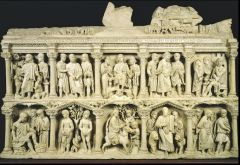
Sarcophagus of Junius Bassus
|
(359 CE) similar romance early christian , raven
• Late Antiquity/Early Christian Art: 4th Century • Junius Bassus was a pagan convert to Christianity and was the city prefect of Rome • The sarcophagus is of eclectic format- decorated only on three sides in the western Roman manner but divided into two registers of five compartments, each framed by columns in the tradition of Asiatic sarcophagi • The deceased does not appear on the body of the coffin- breaking with tradition- but rather there are stories from the Old and New testament • Christ has pride of place and appears in the central component of each register- as a teacher enthroned between his chief apostles |
|
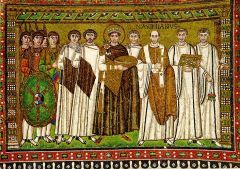
Justinian and attendants
|
• Early Byzantine Art: 547 CE
Byzantine, Emperor Justinian and His Attendants, mosaic from the north wall of the apse, San Vitale, c. 547 ; Justinian (nimbed=halo around head) zaries a golden paten that he is donating to San Vitale for the celebration of the mass( used for Eucharistic bread). at his left, bishop Maximianus holds a jeweled cross & other churchman holds jewel-covered book. government officials on his right. |
|
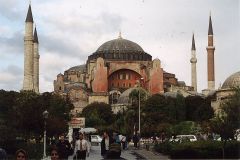
Hagia Sophia
|
532 CE Byzantine, Anthemius and Isidorus, Church of Hagia Sophia, Istanbul, Turkey (formerly
Constantinople or Byzantium),"", view from the southwest cathedra ; (means Holy wisdom) designed by two scholar-theoreticians. embodies imperial power & christian glory. Dome provides a golden, light-filled canopy above space. hybrid of longitudinal and central architectural planning. flanking conche= semidomes. dome rests on 4 pendentives (triangular curving wall sections. huge supporting piers |
|
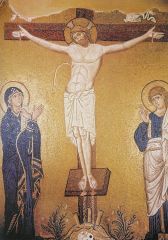
Crucifixion, (su dong dinh)mosaic from Daphne
|
1090 CE Byzantine, Crucifixion, Church of the Dormition, Greece, 11th century, mosaic
Tempera and gold on wood panel. Coppo di Marcovaldo, Crucifix is made from |
|
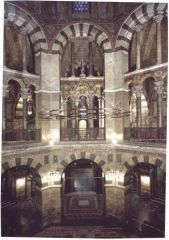
Palatine chapel
|
Palatine Chapel of Charlemagne
architect: Odo of Metz located: Aachen, Germany period: Carolingian date: 805 CE • desire to re-create the classical past • engineering skills lost; overbuilt • central plan church but octagonal, not round • three functions = mausoleum, chapel, martyrium housing holy relics • black & white pattern is borrowed from Islamic architecture |
|
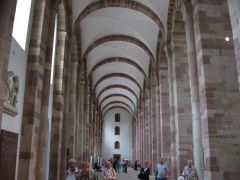
Interior of speyer cathedral
|
Durham Cathedral
period: Romanesque ,person build : Gislebertus date: 1082 • first use of ribbed vaulting • built as part of Norman complex; style moves to Norman churches on continent • eclectic interior, with different designs on columns • once would have been brightly painted • still heavy piers, which makes it Romanesque despite the rib vaulting |
|
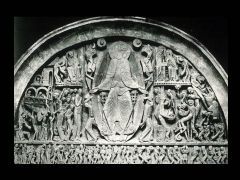
tympanum at autun cathedral
|
Tympanum, St. Lazare, Autun, France
location: Autun, France period: Romanesque date: 1120 • shows Last Judgment, including souls being weighed and figures consigned to hell • a church on pilgrimage route – church militant • view of Christ as judge rather than Christ as savior |
|
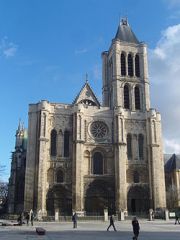
Ambulatory at St. Denis
|
1144
Gothic person built: Fuger St-dennis abbey church Plan of choir View of choir ambulatory and chapels |
|
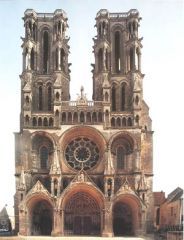
West Facade of Laon Cathedal
|
1190
Gothic Laon, France. |
|

Chartres Cathedral
|
France
Gothic 1145 |
|

west Facade of Reims Cathedral
|
Reims Cathedral. Visitation, jamb statues on west facade
Creation Date: 1290 Gothic Period/Style: French Gothic Medium/Dimensions: Stone sculpture, figures over life size Repository/Location: West Facade central doorway, Reims Cathedral, Reims, France |
|
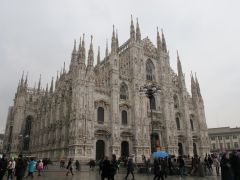
Cathedra of Milan
|
1386
Gothic in the Italian |
|
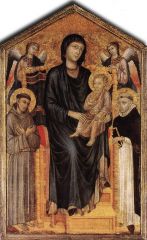
Madonna Enthroned
|
1310
Proto Rennasaince Giotto Lamentation Scene from the Arena Chapel -Giotto sort of comes out of no where and unleashes a new type of style - Monumental Style - called this for once, the art seems substantial. -Shows a sense of space; Angels set in space; shows people form all angles, even the back, which was unseen at the time. - shows landscape in the background which shows Giotto's attempt to make the painting more real. |
|
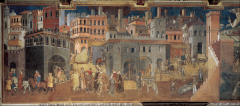
Allegory of Good Government
|
1338
Italian proto Rennasaince -Ambrogio Lorenzetti -Sala della Peace, palazzo Pubblico, Siena (left half of mural) |

